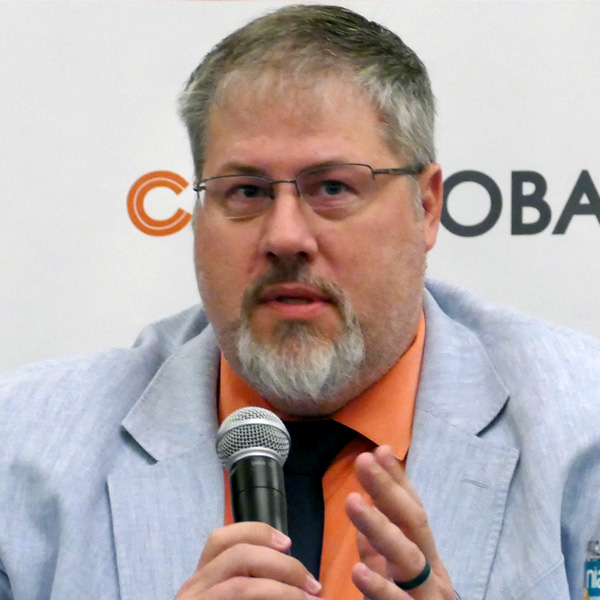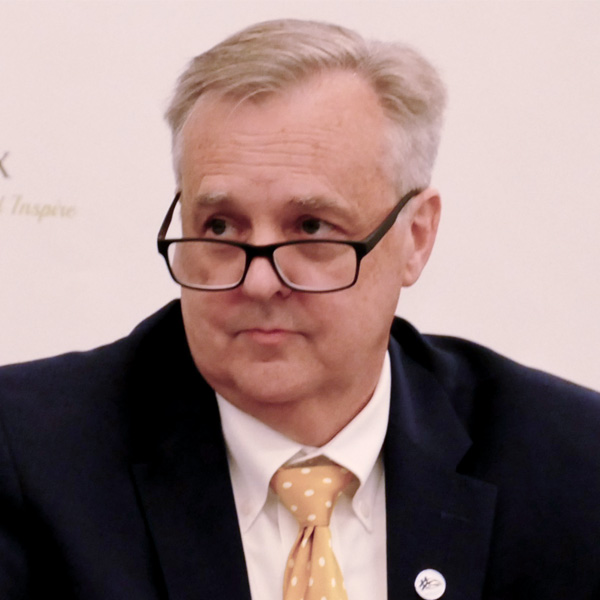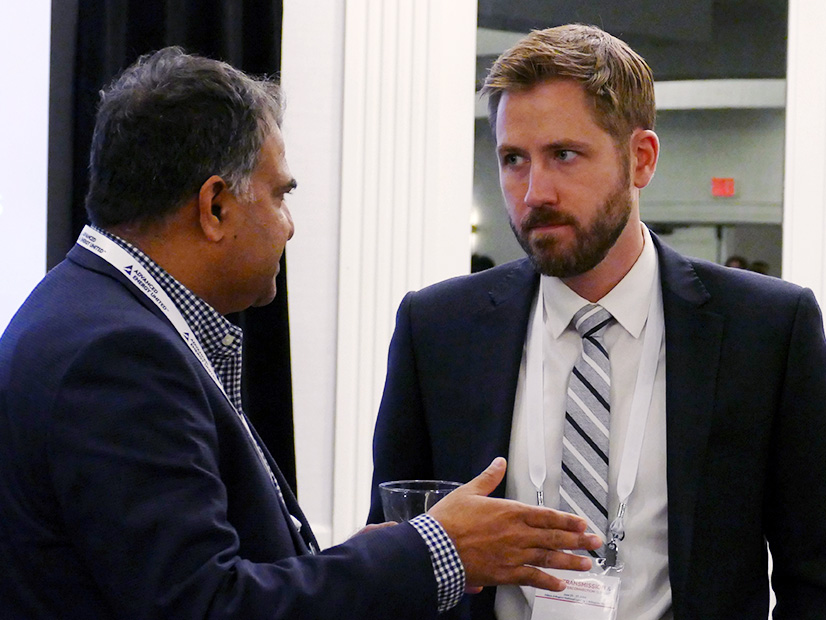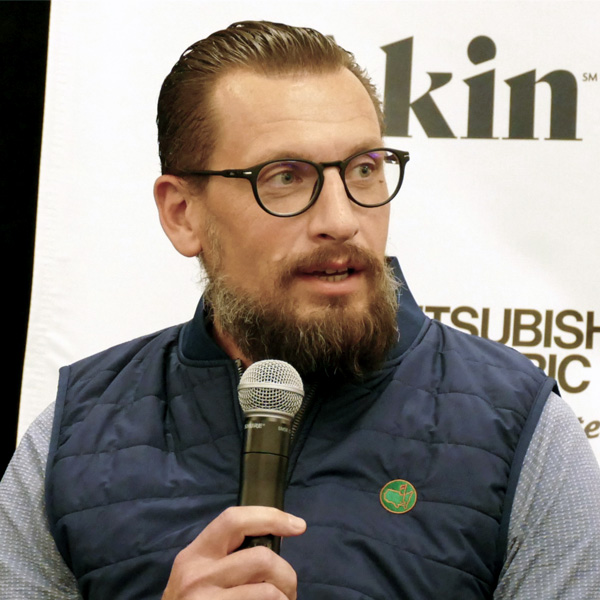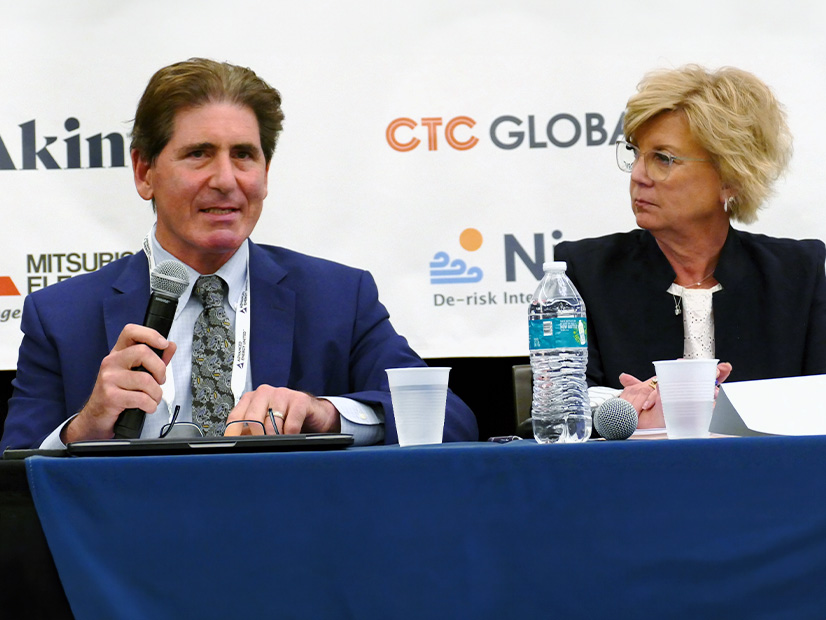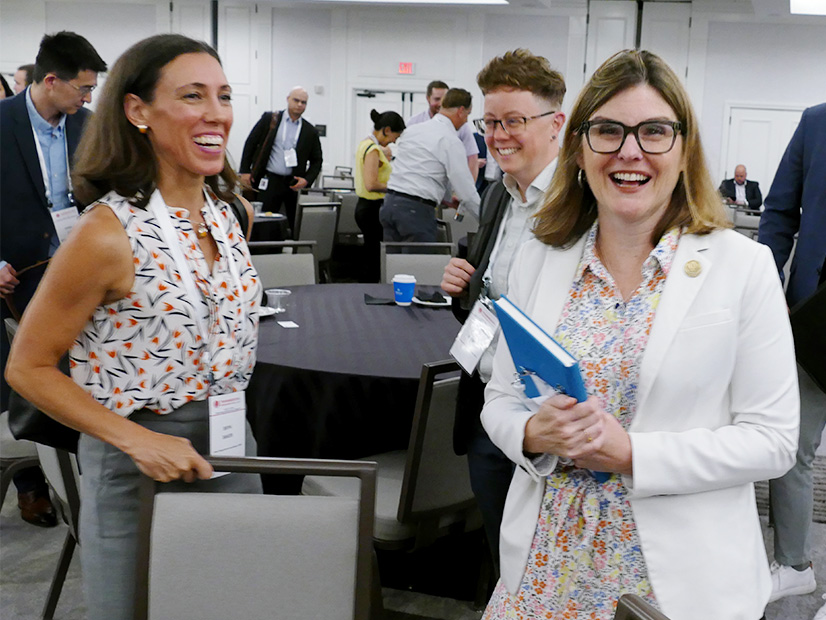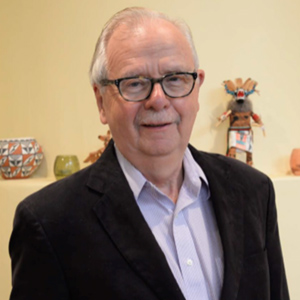ARLINGTON, Va. — Industry leaders, experts, policymakers and regulators gathered near the nation’s capital June 25-27 to discuss how recent FERC orders will affect regional transmission planning, cost allocation, permitting, advanced transmission technologies and other factors that could improve the ability to quickly add capacity to the grid.
Over the last two years, FERC has issued several orders designed to revise transmission planning, cost allocation and permitting processes, including:
-
-
- Order 2023, which revises the commission’s pro forma generator interconnection queue rules to speed up the backlogged process. It has already led to a flurry of interconnection and queue reforms by grid operators and utility balancing areas. (See FERC Updates Interconnection Queue Process with Order 2023.)
-
-
-
- Order 1920, which requires regional transmission planners to model at least 20 years ahead of time using multiple scenarios while taking into consideration a set of seven benefits. (See FERC Issues Transmission Rule Without ROFR Changes, Christie’s Vote.)
-
-
-
- Order 1977, which implements FERC’s new congressionally mandated authority to site transmission lines in a National Interest Electricity Transmission Corridor, despite state regulators’ rejections.
-
While the actions have begun to bear results, the extent of the reforms and their pace vary significantly in the nation’s organized markets.
Joseph Rand, an energy policy researcher at Lawrence Berkeley National Laboratory, kicked off the summit by sharing the lab’s annual analysis of interconnection data from all seven RTOs and ISOs and 44 non-RTO utilities, representing more than 95% of the U.S.’ currently installed capacity.
The report found potential new capacity in interconnection queues is growing dramatically, with nearly 2.6 GW of total generation and storage seeking connections to the grid last year. More than 95% of that capacity is for zero-carbon resources. Solar and battery storage are the fastest-growing resources, accounting for over 80% of new capacity entering queues last year.
“I’ve been working in the energy and electric industry for maybe about 15 years now, and I don’t often get to use the unit of terawatts. One terawatt — my mind was blown,” Rand said. “Then we got to 2 TW last year and now we’re at 2.6 TW, and my mind continues to be blown by this number.
“To put that in context a little bit,” he added, “that’s actually more than two times the installed capacity of our entire electric generation fleet in the United States.”
Rand urged attendees not to place too much importance on recent industry chatter regarding concerns with load growth, resource adequacy, data center energy needs and the impulse to quickly build gas generation. He said there’s enough capacity in grid operators’ queues to meet rapidly increasing load.
“I think that kind of indicates that, again, it’s not necessarily a need to kind of shove through a lot of generation,” he said. “There’s, in fact, a need to kind of unlock this bottleneck that we’re seeing in the interconnection process to meet that resource adequacy. But, like I just alluded to with the word ‘bottleneck,’ we have some problems in this process, right?”
The chief problem, Rand said, is the “very low” completion rates for projects. He said researchers have found that only about 20% of projects that enter queues reach commercial operation and over 72% have withdrawn their applications.
Not that low completion rates are “entirely a bad thing,” Rand said.
“Low completion rates could be a sign of a very active and competitive interconnection process and a competitive market,” he said. “But on the other hand, when you see very low completion rates, those of you from ISOs and RTOs could probably attest to this, it’s really a drain on transmission provider resources to have to study all of these requests. It might be an indicator of so-called exploratory or speculative requests being in this process.”
The other problem? Timelines, especially in FERC-jurisdictional regions, and the rising cost of interconnections.
“This stuff matters and it’s important and it’s why interconnection is sort of top of mind and getting headlines in The New York Times these days,” Rand said.
ERCOT Offers GI Lessons
If there’s a model to ease the bottlenecks in GI queues, it could be ERCOT’s “connect and manage” approach to transmission interconnection. The Texas grid operator focuses its studies on the local upgrades needed for a project to connect to the grid. It manages grid congestion caused by a new generator through market redispatch and curtailment.
ERCOT has added more generation to its system than any other grid operator and transmission provider during the last few years. It connected 14.2 GW of capacity during 2021 and 2022. PJM, with demand twice as large as ERCOT’s, added 5.6 GW during that same period. ERCOT says its lack of FERC jurisdiction status allows it to energize transmission lines in three to six years, compared to seven-and-a-half to 13 years elsewhere.
During a panel discussion on the “connect and manage” approach, Mario Hayden, Enel North America’s transmission director and a former ERCOT staffer, said familiar concepts in other regions get thrown out the window in the grid operator.
“There’s no such thing as a queue priority, which is sort of a fundamental concept in other parts of the country. There’s no sense of other readiness milestones, the concept of site control being a big barrier of entry,” he said. “You do not have a sense of withdrawal penalties, a sense of harming your competitors next to you, direct-cost allocation as a part of the negotiating process, but no idea of transmission upgrades that may cause high costs and make people want to withdraw.
“If you’re a lucky generator, the process is fairly simple,” Hayden said.
Except allocated transmission costs come later. Zero Emission Grid founder Mike Tabrizi said that without a cluster-study process, developers are connecting to the grid at their own risk.
“You’re not going to be responsible for transmission operating costs upfront but once the project becomes operational, then you’re fully exposed to what’s going to happen to the transmission from the congestion … especially if you’re a network resource,” he said.
“[ERCOT lacks] any sort of proactive transmission planning which, as we’ve seen, there can be [generation transmission constraints] that pop up and that will lead to cascading outages if they’re not managed properly,” Pine Gate Renewables’ Regan Fink said, referring to ERCOT’s South Texas constraints.
Tyler Norris, formerly with Cypress Creek Renewables and now working on a doctorate at Duke University, calls the ERCOT’s use of curtailment for renewable energy “flexible interconnection,” although he would prefer the curtailment be “occasional.”
“Once you’ve decided to use the interconnection process to identify and allocate funds for network upgrades, that introduces a lot of complications and sort of the fundamental linkage that we’ve made as we have linked interconnection service to capacity eligibility,” he said. “That’s sort of what I think is driving a lot of the issues that we’re seeing in our interconnection queues.”
FERC staff have scheduled a workshop Sept. 10-11 on GI innovations and efficiencies, Norris noted. He expects flexible interconnection options to be part of the discussion.
“There’s ever more pressure to get more generation on the system,” Norris said. “The FERC staff generally really get that there are a lot of colliding trends. … FERC will be interested in exploring reform options for energy-only interconnection service and provisional service to streamline them and make them more aligned with generator willingness to be curtailed, to get online more quickly.”
More Transmission Coming
A panel discussing the effects of Order 2023’s compliance plans said many regional markets are already a step ahead of FERC. That and competition between the states will continue to lead to strong projects, they said.
Matt Pawlowski, vice president at NextEra Energy Transmission and a “transmission guy” who wants to “build more transmission,” pointed to reforms SPP has made in its GI process to eliminate a backlog of project requests that dated back to 2017. The RTO hopes to clear all requests submitted through 2022 by the end of this year. (See “Staff Reveals Error in GI Queue Studies; Clearing Backlog Still on Course,” SPP Markets and Operations Policy Committee: April 16-17, 2024.)
“[SPP’s reforms] increased site control requirements, increased study deposits and more at-risk study deposits. We supported that because we felt like that would create stronger projects in the interconnection queue,” Pawlowski said. “It certainly sharpened the pencils on our side for ensuring other projects that get into the queue are some of our top projects that we’ve that we’re looking at from both from a demand standpoint, but also from site control and other aspects. Having a little bit more stringent requirements … just forced developers to just think harder about their projects.”
Bill Bojorquez, a former ERCOT executive and now CEO of technology firm Splight, said competition between states for transmission solutions has increased, with siting decisions “taken in by more and more regulatory and government forms.”
“If they don’t do something, we’ll have transmission in other states, wherever is more proactive in justifying that addition,” he said.
“I can’t agree with you more,” Pawlowski said. “I think the states that are being proactive right now in thinking about economic development first and then the steps that are needed in order to fulfill those jobs and economic development plans are going to win. [States] like Oklahoma and California, with some of their plans, are recognizing these. These [massive data centers and cloud infrastructure] want to be close to eyeballs and there are certain areas that they want to pick. If you’ve got them in that area and you don’t have the ability to serve them, they will go somewhere else, because they don’t have the power needs that serve them. It’s as simple as that.”
Allocating Costs the Issue
Finding herself sitting next to FERC senior energy industry analyst David Tobenkin, North Dakota Commissioner Sheri Haugen-Hoffart, an apparent opponent of Order 1920, was quick to respond after his explanation of the order and the states’ role in its cost allocation.
“For full disclosure, when David sat down, he said, ‘Be nice.’ I said, ‘I promise. I will,’” she said as Tobenkin allowed himself a smile. “But I kind of have to give you a look. 1920?”
“We are an export state. We have different challenges compared to other states, but cost allocation — and I wish I wrote down every time I heard cost allocation is challenging — is very challenging and complex,” Haugen-Hoffart added. “We have viewed it in North Dakota as cost-causation principles must be a year two, transmission and interconnection investment caused by companies that state a desire to new generation, regardless of type, should be paid by those parties, the cost causers. To allocate costs of such investment to all customers, in particular RTOs, we see as unjust and unreasonable.”
Yes, allocating costs for transmission is tricky, said WIRES’ executive director, Larry Gasteiger.
“The two biggest obstacles we keep seeing with getting transmission built, and this is really a gross oversimplification, are nobody wants to see it and nobody wants to pay for it,” he said. “Believe me, I get it. We’re talking about a lot of investment. We’ve got a lot of policies going on concerning the issues of paying for this infrastructure, and frankly, it’s going to cost a lot of money.
“I think it’s going to require a conversation and being more honest with ratepayers about what we may be seeing down the road,” Gasteiger added. “That doesn’t mean we don’t look at ways to try to minimize the costs associated with building this infrastructure, absolutely. We have to do that. But we’re not going to cheap our way out of this.”
Speaking on a panel focused on grid-enhancing technologies (GETs), EDF Renewables’ Temujin Roach shared similar opinions.
“People are going to start talking about transmission. It’s become a bigger and bigger issue because it’s going to become a bigger part of their bill. Before it was just pennies. Nobody cared about whatever transmission is,” Roach said. “Now, it’s that much more, so we’ve got to find a way to cut some of the costs while we’re increasing the costs, because we are going to increase the cost. It is going to cost more. We are going to have to charge people to build this transmission, period. So now it’s about how can we manage the cost?”
Clements’ Contributions Recognized
Conference organizers thanked outgoing FERC Commissioner Allison Clements, making her annual appearance to the Infocast summit on her penultimate day on the job, for being “a champion of the industry.”
The WATT Coalition went one better, presenting its 2024 Grid Innovation Champion Award to Clements for being “a true leader in embracing innovation” and advancing transmission technology policy at FERC.
“[Clements] has looked for opportunities to use common-sense solutions like [GETs] to support the FERC’s mission to ensure just and reasonable rates and reliable power,” WATT Chair Hilary Pearson said. “The WATT Coalition thanks Commissioner Clements for taking the time to understand the value of [GETs] on the transmission grid and for consistently advocating for policy to address the structural barriers to grid modernization … we hope her colleagues on the commission will carry forward after her term ends.”
Clements has been an outspoken supporter of GETs. She has praised the technologies in FERC Orders 881 and 2023, in letters to legislators, and in her remarks at NARUC’s Federal-State Joint Task Force on Electric Transmission and other forums. (See FERC’s Clements Gets GETs’ Benefits to Grid.)
“I didn’t think I’d become a champion for grid-enhancing technologies. I didn’t know what one was, and I feel like this real Pollyanna running around cheering for this hardware and software,” Clements said. “But it kind of came on to me because you get one group come in and they say, ‘These are the actual results in savings. These are the actual congestion-cost savings that we got in one year. And this is how much it costs to put it in place.’
“And then you get the advanced conductor guys coming in and saying, ‘This is actually the difference you can make to what’s happening on the grid, whether it be related to sag and wildfire safety, whether it be to making more training or sending more electrons through what-have-you’ … the numbers are so staggering. I think there are pretty credible studies related to the opportunity that hardware and software have to create space and even especially to increase reliability,” she added.
A day before leaving FERC, Clements took solace in her award.
“This just means the world to me. I really appreciate it,” she said with a final commission meeting still on her schedule. “I’m going to take a long vacation and then I’ll be back cheering for grid-enhancing technologies in one capacity or another.”
The vacation began early. Clements stayed around after the ceremony, greeting well-wishers while clutching her award in one arm and a beer in her other hand.
